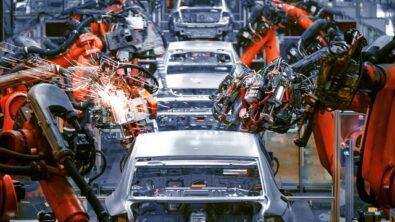On the road to the autonomous supply chain

How enterprises plan to manage supply chain risks
German industrial giants such as Dräger and VW are strategically deploying digital planning and control tools to better manage the dramatic rise in risks to global supply chains.
“It’s about keeping a lid on external factors that impact the supply chain,” explained Volker Rügheimer, Head of Supply Chain Development at Volkswagen Group After Sales, speaking at the Siemens Digital Logistics Supply Chain Forum in Frankfurt. Rügheimer is responsible for optimizing the Group’s supply of parts to 110 million customers—a network involving 6,000 suppliers, including 5,000 in Europe alone.
Monitoring risks, supporting the company’s objectives, identifying opportunities: The automotive giant streamlines its supply chains with the help of the digital twin from Siemens. The virtual management tool, which uses actual data to simulate various risks and threat scenarios for the supply chain, helps the company decide how to optimize its logistics processes.
More transparency, lower costs
VW gains greater visibility over empty container transports, can plan deliveries proactively, and is cutting its costs and emissions. “The digital twin is becoming the architect of the supply chain as supply chain managers morph into data specialists,” says Rügheimer, describing how the digital revolution has redefined traditional roles in logistics. “The digital twin shortens the path to the autonomous supply chain,” the VW manager said at the industry meetup of leading supply chain experts. It has helped better manage the supply chain risks that have plagued the industry as a result of the pandemic and the war in Ukraine while making it easier to integrate automotive trends and strategic issues such as sustainability into supply processes.
Dräger, the medical technology group based in the northern German city of Lübeck, also relies on digital tools to manage its supply chain. Whereas in the past transport orders were processed by e-mail, in the future the approximately 1,000 suppliers will be managed via automated systems. The winner of the BME eSolutions Award 2021 relies on the cross-system cloud solution AX4 from Siemens Digital Logistics for its end-to-end procurement process. “Efficient and transparent material procurement is one of the core elements of a good supply chain. Dräger depends on a reliable supply chain for on-time delivery to our medical and safety technology customers,” said Nicola Klockmann, Supply Chain Manager at Dräger.
Even small and medium-sized transport and logistics companies are increasingly turning to digital logistics to optimize their supply processes. One example is Reichhart Logistik, a family-owned business based outside Munich with 750 employees and 14 locations in Germany, Austria and France.
“Our goal was to reduce the complexity of our transports while professionalizing the planning and execution,” explains Katja Gerads, who heads the Transport Logistics Tender Management team at Reichhart Logistik. They also maximized the efficiency of their transports using the Supply Chain Suite from Siemens Digital Logistics, a planning tool that uses simulations to optimize processes. One example was to reorganize one-way supply trips into round trips to better utilize trucks and avoid deadhead runs. The result: Within one year, Reichhart Logistik was able to significantly optimize a customer’s transports. This was reflected in an improved utilization of the trucks by 18%, a reduction in transport costs by 13%, and cut CO2 emissions by 22%. “Logistics is a data-driven business for us now,” Gerads emphasizes.
Turning work into a hobby
“The virtual part of business is getting bigger,” underscored Dr. Pero Mićić, Founder and CEO of the Future Management Group. Mićić cites Tesla as a shining example of visionary concepts and high-level process automation and theorizes that “physical labor will become a hobby” as large areas of production and logistics eventually become autonomous as well.
“Supply chains need to be rethought,” concluded CEO Volker Albrecht and VP Consulting Jürgen Schulz of Siemens Digital Logistics, speaking at the Supply Chain Forum. This would go beyond just ensuring greater supply chain resilience. Albrecht believes significant value could be added by better aligning industrial production and logistics: “Today’s digital technology transforms the supply chain into a value chain.”


